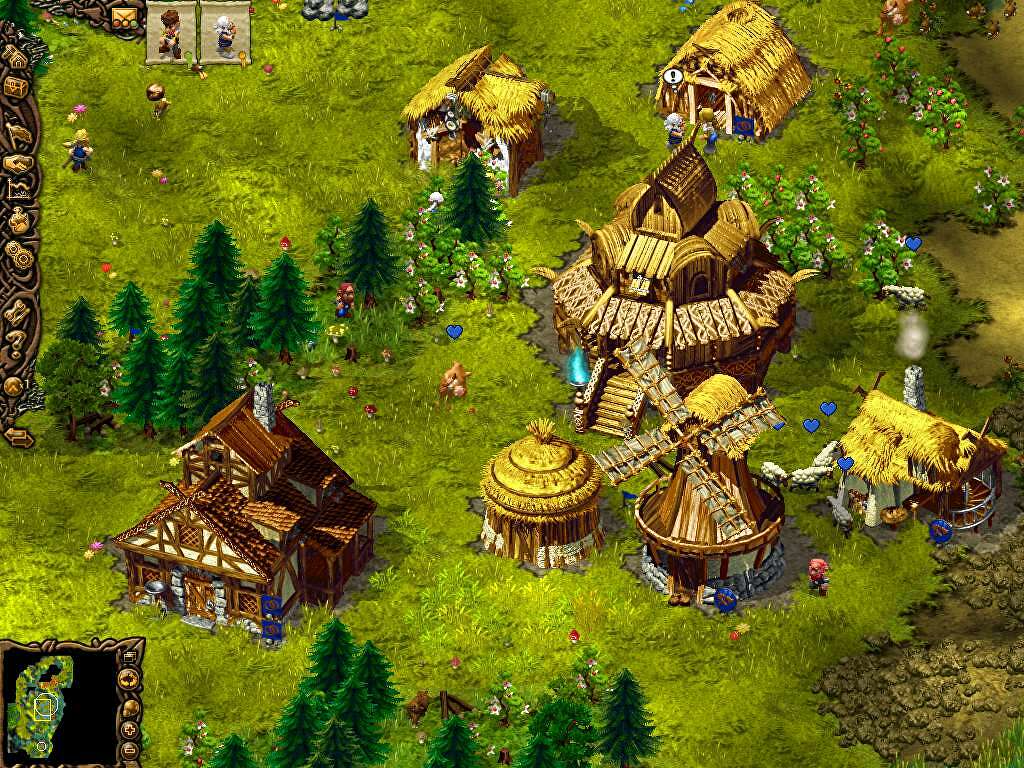Returning to The Gates of Asgard
How a 2002 real-time strategy game, charming as it still is, appears surprisingly antiquated from today’s perspective

2007. My dad has a present for me, all the way from Germany: a collection of games developed by JoWooD. A single video game can get any 8-year-old excited, let alone several of them. A few seconds is all it takes for my nails to prise open the CD case and plop the disc into the CD drive of my desktop computer.
A Jurassic-era Pentium 4 CPU, 256 MB of RAM and an NVIDIA GeForce 7300 card warms the living room as the CD whirs to life. True, it is no predatory machine that can chew through benchmarks, but it does the job of rendering pixels that have some semblance of meaning to them. The static from the speakers can put the radio to shame. The keyboard is as ordinary as they come and the mouse feels like a World War relic, with clicks that go from tactile to tiresome.
The game needs no additional downloads; I didn’t possess an internet connection for such exorbitant matters. After an installation that takes ages, the title screen pops up on my matte monitor. Cultures 2: The Gates of Asgard.
Mere days after the reveal of Assassin’s Creed Valhalla amidst the Great Pause of 2020, viewing JoWooD’s own foray into the Northern Realms as outdated would be an understatement. But its charm shines through the invisible chinks of the pixelated armour donned by Bjarni and his intriguing company. The game kicks off with a cutscene that prophecies Ragnarok, a decisive battle foretold by every game that deals in Norse myths, the end to all beginnings.

The Gates of Asgard
Bjarni, a living and breathing Viking trope of a lad, dukes it out with a massive crimson serpent, but he is not alone. A spear-wielding Franconian (your everyday knight in shining armour), a Saracen equipped with a fine beard (and a scimitar) and certainly, a woman whose attire does more to attract than to protect (she’s got a bow too) come to his aid. As the vision ends, Bjarni wakes up, afraid of what the future holds in store. A cliched start is all it takes for our hero to leave his sleepy village. In search of destiny. The goosebumps have arrived.
While the narrative is rather run-of-the-Viking mill at times, it has its moments. The perpetual ‘Yo!’s of Bjarni’s supposed Scandinavian accent accompanies a captivating soundtrack as you do what Vikings did best: navigate the game’s 11 missions. The campaign takes you through a cornucopia of low-res dotted landscapes, from the lush lands of Normandy to the dusty dunes of Baghdad (and some hellish volcanoes thrown in for good measure). Sprawling maps await, packed to the brim with quests, resources, settlements that either open for trade or unsheathe their blades, hidden chests (some hold buildings) and wild animals who conveniently happen to be in their vicinity.
The intricate attention to detail that had gone into the architecture of these civilizations is impressive.
Byzantine tents, Scandinavian temples and Franconian castles alike are carefully rendered, albeit in a form that may benefit from improved textures and a higher resolution, even for its time. But the fact that a Viking longship acts as your base of operations is one that can satisfy any edgelord out there.

A brave new world
Cultures 2 presents you with the good fortune of meeting several quasi-historical figures, from the evergreen Robin Hood to Sinbad and more. Some of them join you on your quest, as foretold, but all they do is wait about for a fight. While they have more health and considerable fighting prowess, they have no skills to build on, no traits that make them unique and lack the ability to switch weapons. They don’t even tend to the chickens. At least they can’t die of hunger like the rest of your villagers, who have hunger and sleep levels. But villagers possess something that heroes ironically do not: skills that can be levelled up.
Combat is itself fairly minimal. Preparing for it is far more gruelling and painstaking, from crafting weapons and armour to training soldiers, one by one. Heroes do most of the heavy-lifting here, with powerful attacks and lengthy health bars. You’ll get through most conflicts as long as you employ tactics and are in greater numbers.
Tactics, you say? Manoeuvres such as keeping your archers away from the heat of battle count too. The AI is such that enemy villagers often just keep chatting to each other as you hack them to shreds in true Viking spirit. Catapults make short work of towers and fences, letting you advance on unsuspecting foes with ease.

While almost all the missions place city-building first and foremost, some sections do contain military encounters.
But these are few and far between, like wandering about in a cave to rescue a princess from French knights (it’s a-me, Mario!) or making it through a forest filled with wild animals. These sub-sections offer a welcome respite from the tedious nature of methodically developing your settlement
Settle settlements
With the premise out of the way, the meat of this well-worn whale lies in its comprehensive yet perhaps complicated city-building system. Some have termed it a chore, while others point to various games that have simpler learning curves.
Juggling between construction and the production of goods that can be used to make more goods, so on and so forth, lies at the heart of Cultures 2.
The speed with which your village develops can be likened to droplets of water gradually winnowing a melting glacier; eternal punishment to some. But while Cultures 2 does serve up healthy doses of satisfaction with every milestone, some parts work better than others. Trading is one facet that perhaps wasn’t given the attention it deserved during the game’s development. It remains a puzzle to this day, with commands that fail to make sense. Another enigma is the social interaction that your Vikings require to go about their lives. Stopping to chat is one thing, but running across the length of your encampment in vain as busy workers ignore your villager’s pleas to socialize is a peculiar conundrum.
Few have the patience to deal with a convoluted technology tree that links everything from wheat to mead. From a farmer to a miller to a baker, every resource can be improved upon, giving your village what it needs to expand, be it food, construction materials or tools and utensils. Heck, religion is a resource too; a rather interesting interpretation. Regardless of your beliefs, faith is generated by having oil at homes to light blue ‘sacred’ flames and is used for advanced tasks such as smelting weapons or gold.
This is merely a glimpse into the chains of professions that your Vikings may find themselves in. What drove an 8-year-old to even the odds was determination. Or desperation. Games didn’t come very often, so I milked the cow of every last drop it had.

Not all who wander are lost
Shrieks pierce the air, cutting through the merry flutes of the mellow Vikings.
“Get down here for lunch!”
“I’m coming, mom.”
Perhaps it is greed. Or perhaps it is the faith I place in my fellow comrades. I had named each one of them, man and woman alike, with names of friends and family. Names hold power. Of sentiment and immersion. They even have their own family trees at this point, with some questionable unions. I didn’t pause the game, hoping I’d have bricks and more resources await my command.
I return to a mountain cluttered with corpses.
A band of hungry Vikings had set out in search of fruit to abate their mumbling bellies. But when they came upon it, they found themselves lost. Without signposts to guide them back, nature ran its course. Needless to say, I had to load a previous save (time travel to the rescue) and command my scout to erect a couple of wooden posts across the land. It turned out that wolves and bears could either read signs or were absurdly good at finding villagers. A feud that Bjarni’s blade did settle.

Some are more equal than others
As an 8-year-old, thoughts such as prejudice and bigotry were reserved for the bullies that populated schools. Little did I know then that I had failed to recognize misogyny when it looked me in the eye.
You may have noticed I haven’t spoken about women so far. This is because of how their roles are restricted, in much the same way as they are in some societies today. Parental pressure is one thing, but treating women like baby-making machines is downright ugly. In Cultures 2, women supposedly have nothing else to do but gather essential home supplies, cook and make little Vikings.
Apparently, this was okay because the game is set in The Dark Ages complete with a literal stork delivering the baby at your doorstep in the event of childbirth. Even this choice is taken away from them; for married women can be ordered to produce sons or daughters on demand, one at a time. Appalling. A sign of the times.
The fact that the player is presented with a choice between having a son or daughter sheds light on a fundamental flaw that has plagued society for centuries. Why could women not become builders, farmers, or hunters instead? Why could they not involve themselves in the betterment of their village, not go to schools and become soldiers to protect the land? Could they not build homes and warehouses instead of relying on manpower?

Perhaps a game that’s older than some of you reading this can get away with the way it handled the representation of women, but it is certainly a lesson for game developers who wish to cater to under-represented groups in future endeavours. Perhaps it was done with no ill intent, but it still promotes conformity to orthodox norms that ought to be abolished
In the future, critics may look at the games of today and pan them for the way they segregate humanity, in the hopes that subsequent iterations eliminate this evil, opening a gateway to a childhood free from adulteration.
Final thoughts
The Sims. Norse city-building. Casual combat and exploration. Stir gently and you’ll concoct an interesting result, one stuffed to the gills with cutesy Vikings in search of adventure and intricate tech trees you can lose yourself in. While your mileage may vary with respect to the lengths of developing it, steadily micromanaging your way from point A to B with Cultures 2’s soothing soundtrack is a joy that one will certainly cherish. Some may be put off by the slow development of the economy, while others may relish it.
Leisurely watching a village grow from a single building to a bustling town, akin to an anthill, is a pleasure few games offer today, for they have had to adapt to dwindling attention spans and shared worlds. But this is your world alone: you determine what to raise or raze. Add to that the cross-cultural banter that occasionally gets in the way of your journey across Byzantine and Franconian lands and you have a formula that stands the test of time, eighteen years later.
